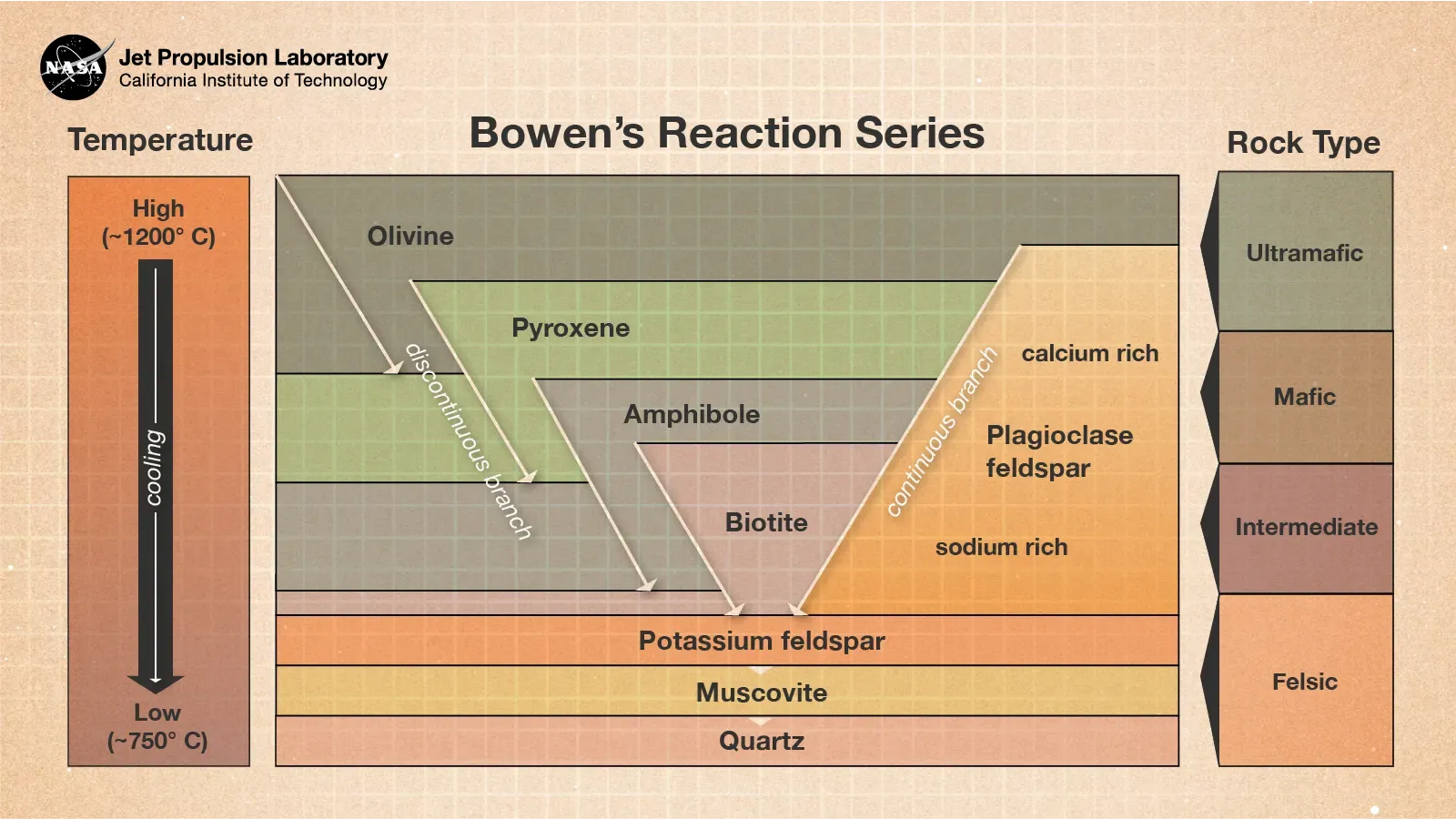Bowen's Reaction Series
What is Bowen's Reaction Series?
Bowen's Reaction Series is a way of organizing minerals by the temperature at which they crystallize from magma. It was first proposed by a Canadian geologist named Norman L. Bowen in the early 1900s.
Bowen's reaction series is able to explain why certain types of minerals tend to be found together while others are almost never associated with one another. He experimented in the early 1900s with powdered rock material that was heated until it melted and then allowed to cool to a target temperature whereupon he observed the types of minerals that formed in the rocks produced.
The idealized progression which they determined is still accepted as the general model for the evolution of magmas during the cooling process. As with everything else in geology, there are exceptions to this rule , but for the most part it works.
Bowen determined that specific minerals form at specific temperatures as a magma cools. At the higher temperatures associated with mafic and intermediate magmas, the general progression can be separated into two branches.
The continuous branch describes the evolution of the plagioclase feldspars as they evolve from being calcium-rich to more sodium-rich. The discontinuous branch describes the formation of the mafic minerals olivine, pyroxene, amphibole, and biotite mica.
The weird thing that Bowen found concerned the discontinuous branch. At a certain temperature a magma might produce olivine, but if that same magma was allowed to cool further, the olivine would "react" with the residual magma, and change to the next mineral on the series (in this case pyroxene).
Continue cooling and the pyroxene would convert to amphibole, and then to biotite. Mighty strange stuff, but if you consider that most silicate minerals are made from slightly different proportions of the same 8 elements, all we're really doing here is adjusting the internal crystalline lattice to achieve stability at different temperatures. Really no big deal.
At lower temperatures, the branches merge and we obtain the minerals common to the felsic rocks - orthoclase feldspar, muscovite mica, and quartz (the banana slug of the mineral world).
Simply put, the high temperature minerals, the first ones to crystallize in a mass of magma, are most unstable at the Earth's surface and quickest to weather because the surface is most different from the conditions under which they were created. On the other hand, the low temperature minerals are much more stable because the conditions at the surface are much more similar to the conditions under which they formed.
 |
| Bowen’s Reaction Series diagram showing mineral crystallization order in cooling magma, illustrating discontinuous and continuous reaction sequences by N. L. Bowen. By: Trista L. Thornberry-Ehrlich |
The Bowen’s Reaction Continuous and Discontinuous
The Bowen's Reaction Series is divided into two parts: the discontinuous series and the continuous series.
The discontinuous series is made up of minerals that have different compositions. The minerals in this series crystallize in a specific order, and the composition of the magma changes as each mineral crystallizes. The minerals in the discontinuous series are olivine, pyroxene, amphibole, and biotite.
The continuous series is made up of minerals that have a similar composition. The minerals in this series crystallize one after the other, but the composition of the magma does not change significantly. The minerals in the continuous series are plagioclase feldspar and quartz.
How does Bowen's Reaction Series work?
The Bowen's Reaction Series works by the following process:
- Magma is heated until it melts.
- As the magma cools, minerals begin to crystallize.
- The minerals that crystallize first are those with the highest melting points.
- As the magma cools further, the minerals with lower melting points begin to crystallize.
- The composition of the magma changes as the minerals crystallize.
- The minerals that crystallize last are those with the lowest melting points.
Facts about Bowen's Reaction Series
The Bowen's Reaction Series is not always perfectly followed. In some cases, the minerals in a magma may react with each other in different ways, resulting in a different order of crystallization.
The Bowen's Reaction Series is based on experiments with idealized magmas. The composition of real magmas can vary, which can affect the order of crystallization.
The Bowen's Reaction Series is a simplified model of a complex process. There are other factors that can affect the order of crystallization of minerals, such as the presence of water and other elements.





%20(1).webp)



